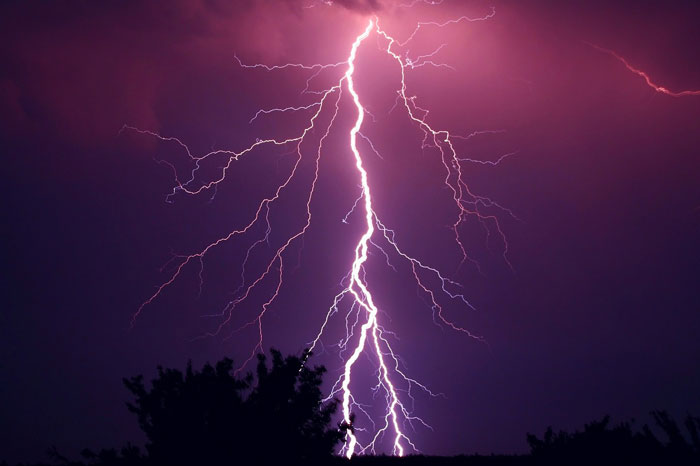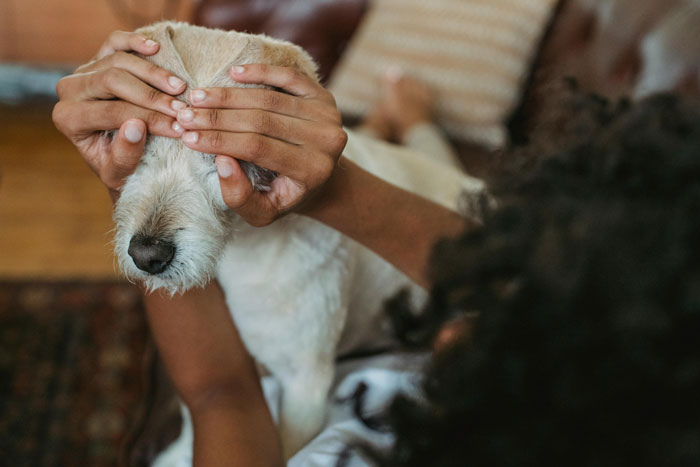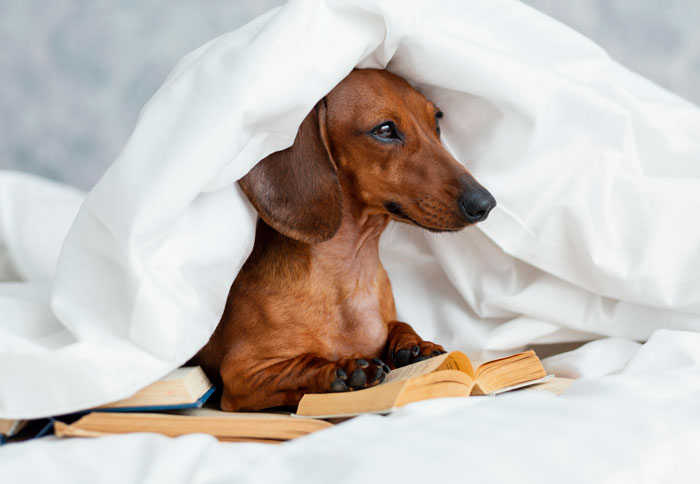It’s heartbreaking to witness our beloved companions in such distress. That’s why it’s crucial we understand how to provide comfort and support to help them cope with their storm anxieties. Simply ignoring or downplaying their fear doesn’t make it go away and can even make the phobia worse over time.
The information provided herein is for informational purposes only. Please refer to ourdisclaimerfor more details..
Table of ContentsWhy Are Dogs Afraid of Thunderstorms?Loud NoiseSensitivityBad MemoriesGeneticsHelping Your Dog Feel Less Scared of ThunderGetting Used to ThunderBuilding Emotional StrengthNatural and Holistic OptionsWhat To Do During a ThunderstormCreate a Safe SpaceDistraction TechniquesCalm and Reassuring PresencePressure WrapsWhen to Seek Professional HelpSevere ReactionLack of ProgressRole of Veterinarian and Canine Behaviorist
Why Are Dogs Afraid of Thunderstorms?
Image credits:ronomore

Thunderstorms present a multi-faceted assault on a dog’s senses and instincts, leading to reactions ranging from mild unease to full-blown phobias, often causing severe fear in dogs afraid of storms. Here’s a closer look at the main reasons why dogs find thunder so terrifying:
Loud Noise
Thunder is sudden, LOUD, and a frequent trigger for a dog’s fear of thunderstorms. Dogs like things to be predictable, so those big booms violate their sense of order. The sound of thunder can make dogs jump and prepare for danger, even when they don’t know where it’s coming from, making your dog feel anxious.
Sensitivity
Dogs hear way better than us, so the low-frequency rumble of thunder is intensified for them. Loud thunder to us is like an explosion to them! This can be really overwhelming and make them feel scared and confused, as well as experience a drop in barometric pressure. Plus, they have other powers we don’t.
Bad Memories
Sometimes, dogs are afraid of thunderstorms because they’ve had a bad experience in the past. Maybe they were outside during a storm and felt scared because they didn’t know what was happening. Your dog might even showsigns of separation anxietyif left alone during a storm. Now, even when they’re safe inside, thunder reminds them of that scary feeling, and theirfear can feel like fireworks.
Genetics
Some dogs are just born a little more nervous, making them more likely to be afraid of storms. It’s like how some kids are more scared of the dark than others. Certain dog breeds, especially those that herd animals, are made to be extra alert.
Helping Your Dog Feel Less Scared of Thunder
Overcoming thunderstorm anxiety isn’t about a quick solution – it’s about building your dog’s resilience over time and helping your dog feel calmer during storms. These strategies work best when done consistently, even outside of storm season, to lessen your dog’s fear of thunderstorms:
Getting Used to Thunder
Image credits:Samson Katt

Desensitization can help your fearful dog learn that thunder isn’t always a threat. This can reduce signs of fear during storms.
Start small.Find high-quality recordings of thunderstorms and begin playing them at a very low volume, barely noticeable at first, so as not to make your dog anxious.
Make it positive.While the sounds of the storm play, engage in fun activities with your dog to create a positive association. Offer high-value treats, play their favorite game, or give them gentle praise and petting to show your dog a safe place to go.
Gradual increase.Over several sessions, gradually increase the volume of the storm sounds, but always stop if your dog gets too anxious. Remember, patience is key when trying to help dogs with noise phobia.
The goal is to change your dog’s association with thunder from fear to something positive (like playtime and treats) or at least neutral. Patience and consistency are key during this noise aversion therapy!
Building Emotional Strength
A confident dog has better emotional tools to handle stressful situations like thunderstorms and is less likely to be afraid of storms. Here’s how to boost your dog’s confidence:
Teaching commands like “sit”, “stay”, and “come” helps your dog focus andbuilds your bond. This provides a sense of control and predictability that can help your dog during a storm. Learning new skills gives your dog a feeling of accomplishment, which further boosts their confidence and helpscalm an anxious dog.
Maintain consistent routines for feeding, walks, and play. Knowing what to expect lowers your dog’s everyday anxiety. Make sure they have designated safe spaces to retreat to when they feel overwhelmed, providing your dog a safe space to help them cope.
Focus on rewarding calm behavior throughout the day, not just during training. Help your dog learn that good things happen when they’re relaxed, and this can help your dog feel calmer during thunderstorms.Avoid harsh corrections or punishment, as these will increase anxiety, damage your bond, and cause your dog’s fear of thunderstorms to worsen.
Natural and Holistic Options
While desensitization and confidence-building are key, natural and holistic remedies can provide additional support, especially if your dog shows signs of severe anxiety and noise phobia:
Calming Supplements
Pheromone Products
What To Do During a Thunderstorm
While the long-term strategies laid out in the previous section are key to overall progress and can help your dog during a thunderstorm, it’s vital to know how to help your dog cope in the moment when a storm hits.
Here’s what you can do to give your dog a safe place and help minimize the impact of the storm:
Create a Safe Space
Image credits:freepik

Ideally, your dog should already be familiar with a designatedsafe space like a crate, a cozy corner in a quiet room, or even a bathroom. Make sure it’s filled with comfy blankets, their favorite toys, and items that have their familiar scent, providing a safe place for when your dog is afraid of thunder.
Distraction Techniques
If your dog is receptive,try engaging them with theirfavorite interactive toysor puzzle feeders filled with high-value treats. The goal is to create a more positive association competing with their fear response and can help them cope with storm phobia in dogs.
Scatter tasty treats around their safe spaceand let them sniff them out. This foraging activity is naturally calming and helps your dog shift their focus, which can help your dog during a storm.
Calm and Reassuring Presence
Your dog looks to you for cues. Staying calm and composed yourself sends a strong signal that there’s nothing to be overly alarmed about.Avoid being excessively coddling, as this can unintentionally reinforce their fear of thunderstorms. But offer gentle reassurance and pets if they seek them out and want to be near you.
Sometimes, simply sitting near your dog’s safe space with a good book or some quiet work can be incredibly comforting and help them feel less afraid of the sound of thunder.
Pressure Wraps
Some dogs find an anxiety wrap very helpful, while others don’t. It’s best to introduce a Thundershirt well before a storm so your dog has time to adjust to wearing it and get used to the sounds of the storm gradually.
Important Note:Even with these strategies, some dogs may still experience significant anxiety and signs of noise phobia during a storm. If your dog is severely distressed, don’t hesitate to reach out to your veterinarian or a behaviorist for further guidance, potential medication options like anti-anxiety medication, and additional support if your dog is afraid of storms.
When to Seek Professional Help
It’s important to know that some cases of storm phobia in dogs are so severe that they require professional intervention for your dog’s safety and well-being. Here are the red flags that indicate it’s time to get help and consult your veterinarian:
Severe Reaction
It’s important to know that your furry friend may become extremely anxious during thunderstorms, which could prompt them to harm themselves physically. This might entail biting, frantic scratching, chewing on walls, and ultimately, shock. Needless to say, if your dog shows these signs of fear, you should seek veterinary care immediately to ensure their safety.
Some dogs become sodesperate to escape the perceived threatdue to their noise phobia that they’ll break through windows, bolt out of doors, or attempt to scale fences and put themselves at risk of serious injury.
If you notice your pet displaying symptoms such asuncontrollable trembling, excessive drooling, hiding, being impossible to coax out, or loss of bladder/bowel control, it is a sign that their level of distress and anxiety is beyond what you can manage alone. It is important to seek professional help from a veterinarian or an animal behaviorist to ensure your furry friend receives the proper care and attention they need.
Lack of Progress
If you’ve diligently implemented the strategies outlined in previous sections for several weeks or months yet see little to no improvement in your dog’s fear of thunderstorms, it’s time to consult a professional. There may be underlying factors that need to be addressed to help your dog manage those low-frequency rumbles.
Role of Veterinarian and Canine Behaviorist
Having a veterinarian check your dog is crucial in the event of severe storm phobia. The vet can first rule out any medical conditions that might be making anxiety worse. This can include hearing loss, thyroid issues, changes in air pressure, and other factors. They can then discuss whether anti-anxiety medication, used in combination with behavioral strategies, is appropriate for your dog’s condition.
A veterinarian who specializes in behavior or a certified dog trainer with credentials likeCPDT-KAorIAABC-ACDBCcan provide customized desensitization and noise aversion therapy, as well as behavior modification techniques. They can help you fine-tune your approach and offer tailored strategies for better results, ultimately making your dog feel safer.
Remember, seeking professional help is not a failure, but a way to give your furry friend the best possible chance to overcome their phobia, manage their separation anxiety, and become less afraid of storms. A veterinary behaviorist can help you with many aspects of storm phobia in dogs.
390views390views
Pet Wellness